
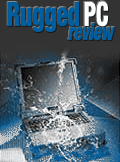
|
|
|
|
|
|
Microsoft Unveils Pocket PCNew York, April 19, 2000 -- Yes, Microsoft has changed the name of its PDA/palmtop/wallet PC or whatever yet again. After 3Com/Palm nixed the initial Palm PC moniker, and Palm-size PC never really caught on, we're now looking at Windows powered Pocket PCs. But "Pocket PC" is more than just a new name. The changes to the platform are far more than just skin deep and Microsoft went out of its way to throw in some truly terrific applications. We will be covering all aspects of Pocket PC, including hardware, software, peripherals, and services in great detail in the next two issues of Pen Computing Magazine. Just in case you can't wait to see two of the greatest new Pocket PCs. Here are early shots of the Compaq iPAQ and the HP Jornada 545. But just so that you don't have to wait, here's a first look at what's new. While the Pocket PC user interface still isn't quite what it should be, Microsoft did a bang-up job with most of the applications that premier with the Pocket PC: Microsoft Reader for Pocket PCMicrosoft announced long ago that the next version of their Palm-size PC would support ClearType display technology, a Microsoft creation to improve readability on Windows CE's LCD screens. At last, the reason behind this technology shows itself. Built into the new line of Pocket PCs, the Microsoft Reader application debuts with the ClearType technology.
Not to be one to leave loose ends, Microsoft has partnered with Barnes & Noble to supply the electronic novels for download via a new eBook superstore being unveiled in the first half of this year. The company plans to offer thousands of eBooks for Windows CE users and bring a rather large marketing campaign to their brick and mortar storefronts. But MS Reader really outpaces the competition with a little help from Audible. In another partnership, Microsoft has built in the “books on tape” audio format into the Reader. Being AudibleReady, means users will have access to an existing library of 20,000 hours of spoken word audio. Being able to read or hear the books of your choice anywhere, anytime is a old capability for Windows CE, but having it built-in to the operating system and supported by the industry giants is huge. Now you can forget just carrying around your personal information manager, Windows CE has become an entertainment system and knowledge base as well. Microsoft Reader will be available on the Pocket PC; the newest Windows CE device arriving in before summer. Microsoft Media Player for Windows CEIf you've purchased a Diamond Rio MP3 player in the last 30 days, find your receipt and return it. Microsoft is about to give you the power to play MP3 audio in the device you already have; your Palm-size PC. Designed so you'd use your fingers and not your stylus, Microsoft has developed a colorful and inviting interface that has controls matching your CD player at home. Users can create a digital music library, using personal jukebox software or by downloading music from the Internet. In addition to MP3, the Windows Media Player naturally includes support for Microsoft's digital rights management technology. This technology is being employed by Sony, EMI, BMG and Warner Music to ensure you pay for music that has copyright privileges. While that might sound like someone's just trying to make a buck, it will encourage the artists to bring their music to the Internet without fear that it could be pirated. Furthermore, Microsoft is reporting their music format offers the same quality of music in less memory. That means that a 2MB MP3 file will encode as a 1MB Media Player file. Quite a large advantage on devices that are memory constrained. MS Media Player is available now for the Casio Cassiopeia E-100/E-105, the Compaq Aero 1500/2100 Series, and the Hewlett-Packard Jornada 430SE as a free download from http://www.microsoft.com/windows/windowsmedia/ and will be built in to the Pocket PC operating system. Pocket Internet Explorer
Pocket Excel
Pocket Word and TranscriberI've always liked Pocket Word on the handheld PC version of Windows CE. Now Pocket Word, appropriately, has come to the Pocket PC. Just like Pocket Excel, Pocket Word is amazingly powerful and able to handle even very long PC documents. It doesn't, of course, support ALL of desktop Word's features, but enough to easily handle at least 90% of my desktop documents. It has some cool features like letting you attach audio recordings and drawings.
Other Pocket PC enhancements
By Conrad H. Blickenstorfer and Dan Hanttula. |
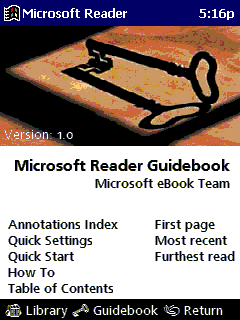 Microsoft Reader is an eBook reader, designed to display electronic novels you can store on your Windows CE device. The company is touting the Reader's simple and well organized display (see screenshot) and notes they have taken measures to ensure wide margins, correct spacing, leading and kerning as well as full justification of the text. They are right on all counts. The program also has book marking, highlighting and annotation features and an integrated dictionary for looking up unknown words. The "library" file system has been specially designed to store large numbers of eBooks.
Microsoft Reader is an eBook reader, designed to display electronic novels you can store on your Windows CE device. The company is touting the Reader's simple and well organized display (see screenshot) and notes they have taken measures to ensure wide margins, correct spacing, leading and kerning as well as full justification of the text. They are right on all counts. The program also has book marking, highlighting and annotation features and an integrated dictionary for looking up unknown words. The "library" file system has been specially designed to store large numbers of eBooks.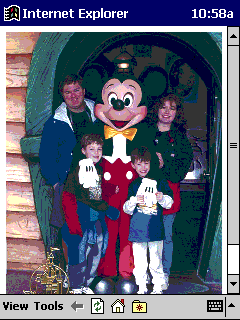 While most Palm-size PC users had to suffer without Internet Explorer, users of the new Pocket PC can rejoice in having the most feature packed web browser Microsoft has ever delivered for Windows CE. In addition to all the standard web browser features we have seen on the HPC version of Pocket IE, the Pocket PC version has: a shrink-to-fit capability (dynamic resize of the web page to facilitate viewing on the Pocket PC's screen), the smart address bar (to anticipate a URL as you enter it) auto-state (so if you're not connected to the Internet the browser will open a cached version of the web page) and XML, the Internet standard Extensible Markup Language to allow Pocket PC applications to use customized web information. The new version of Pocket IE also allows users to download web pages upon synchronization and includes Avantgo code in the browser, so you can subscribe to Avantgo channels and read them in the browser. The browser also supports HTML 3.2; SSL (secure sockets layer), JScript development software and ActiveX technologies. And the Pocket PC joins the HPC and HPC Pro to allow network Internet connectivity, as well as wireless and phone line access.
While most Palm-size PC users had to suffer without Internet Explorer, users of the new Pocket PC can rejoice in having the most feature packed web browser Microsoft has ever delivered for Windows CE. In addition to all the standard web browser features we have seen on the HPC version of Pocket IE, the Pocket PC version has: a shrink-to-fit capability (dynamic resize of the web page to facilitate viewing on the Pocket PC's screen), the smart address bar (to anticipate a URL as you enter it) auto-state (so if you're not connected to the Internet the browser will open a cached version of the web page) and XML, the Internet standard Extensible Markup Language to allow Pocket PC applications to use customized web information. The new version of Pocket IE also allows users to download web pages upon synchronization and includes Avantgo code in the browser, so you can subscribe to Avantgo channels and read them in the browser. The browser also supports HTML 3.2; SSL (secure sockets layer), JScript development software and ActiveX technologies. And the Pocket PC joins the HPC and HPC Pro to allow network Internet connectivity, as well as wireless and phone line access.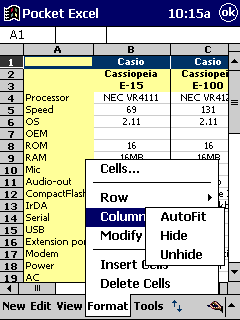 Judging by all the whining from the mainstream computer press types present at Microsoft's Pocket PC Reviewer's Conference, you'd have thought Pocket Excel was the worst thing that happened to them since the repeal of the three Martini lunch. They just didn't get how terrific Pocket Excel is. It'll read any PC Excel file, preserving multiple worksheets and virtually all formatting. I downloaded a 150k Excel 2000 multi-sheet spreadsheet from my notebook and Pocket Excel preserved every last formula and every bit of formatting. It's quick and even allows light editing. What the mainstreamers bemoaned was that you if you changed a spreadsheet on the Pocket PC, then uploaded it to the PC and saved over a PC version of it, you might lose some formulae that the Pocket PC version doesn't support. Well, that's not what Pocket Excel is for. I think it's totally terrific.
Judging by all the whining from the mainstream computer press types present at Microsoft's Pocket PC Reviewer's Conference, you'd have thought Pocket Excel was the worst thing that happened to them since the repeal of the three Martini lunch. They just didn't get how terrific Pocket Excel is. It'll read any PC Excel file, preserving multiple worksheets and virtually all formatting. I downloaded a 150k Excel 2000 multi-sheet spreadsheet from my notebook and Pocket Excel preserved every last formula and every bit of formatting. It's quick and even allows light editing. What the mainstreamers bemoaned was that you if you changed a spreadsheet on the Pocket PC, then uploaded it to the PC and saved over a PC version of it, you might lose some formulae that the Pocket PC version doesn't support. Well, that's not what Pocket Excel is for. I think it's totally terrific.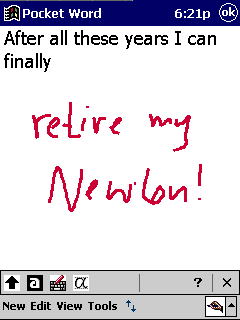 Best of all, by far, is that Pocket PC contains a full implementation of ParaGraph's Calligrapher handwriting recognizer. This is the same technology that eventually made the Newton far and away the best handwriting recognition notetaker. Well, all of that is now available on the Pocket PC. You can write full words, both printed or cursive, anywhere on the screen, even over existing writing, and the recognizer will convert it into text just as on a MP2100. Still a bit gun-shy over handwriting recognition, Microsoft barely mentions the inclusion of CalliGrapher and, in fact, calls it "Transcriber." Be that as it is, it is a landmark step. CalliGrapher/Transcriber works in any Pocket PC app and finally allowed me to retire my MessagePad. Those who follow my columns and writing will realize what a monumental occasion that is.
Best of all, by far, is that Pocket PC contains a full implementation of ParaGraph's Calligrapher handwriting recognizer. This is the same technology that eventually made the Newton far and away the best handwriting recognition notetaker. Well, all of that is now available on the Pocket PC. You can write full words, both printed or cursive, anywhere on the screen, even over existing writing, and the recognizer will convert it into text just as on a MP2100. Still a bit gun-shy over handwriting recognition, Microsoft barely mentions the inclusion of CalliGrapher and, in fact, calls it "Transcriber." Be that as it is, it is a landmark step. CalliGrapher/Transcriber works in any Pocket PC app and finally allowed me to retire my MessagePad. Those who follow my columns and writing will realize what a monumental occasion that is.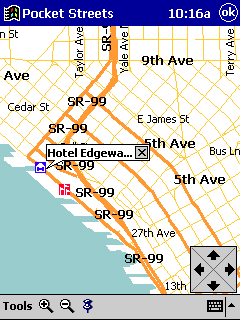 Pocket PC contains a number of other great new applications. Pocket Streets, for example, is included in the box and no longer requires downloading to take advantage of very detailed maps you can take with you. Microsoft Money for Pocket PC can work as a stand-alone application to track bank accounts, transactions, stock portfolios and payments. It also synchronizes with desktop Money. USB synchronization is a true revelation in speed and ease of use. Even large files take no time at all to move back and forth. We'll get into all of this in much more detail in our next issue. For now suffice it to say the Pocket PC applications are extremely impressive and far more powerful than anything we've seen on such a small platform. The same cannot be said (yet) about the overall user interface which remains a work in progress.
Pocket PC contains a number of other great new applications. Pocket Streets, for example, is included in the box and no longer requires downloading to take advantage of very detailed maps you can take with you. Microsoft Money for Pocket PC can work as a stand-alone application to track bank accounts, transactions, stock portfolios and payments. It also synchronizes with desktop Money. USB synchronization is a true revelation in speed and ease of use. Even large files take no time at all to move back and forth. We'll get into all of this in much more detail in our next issue. For now suffice it to say the Pocket PC applications are extremely impressive and far more powerful than anything we've seen on such a small platform. The same cannot be said (yet) about the overall user interface which remains a work in progress.